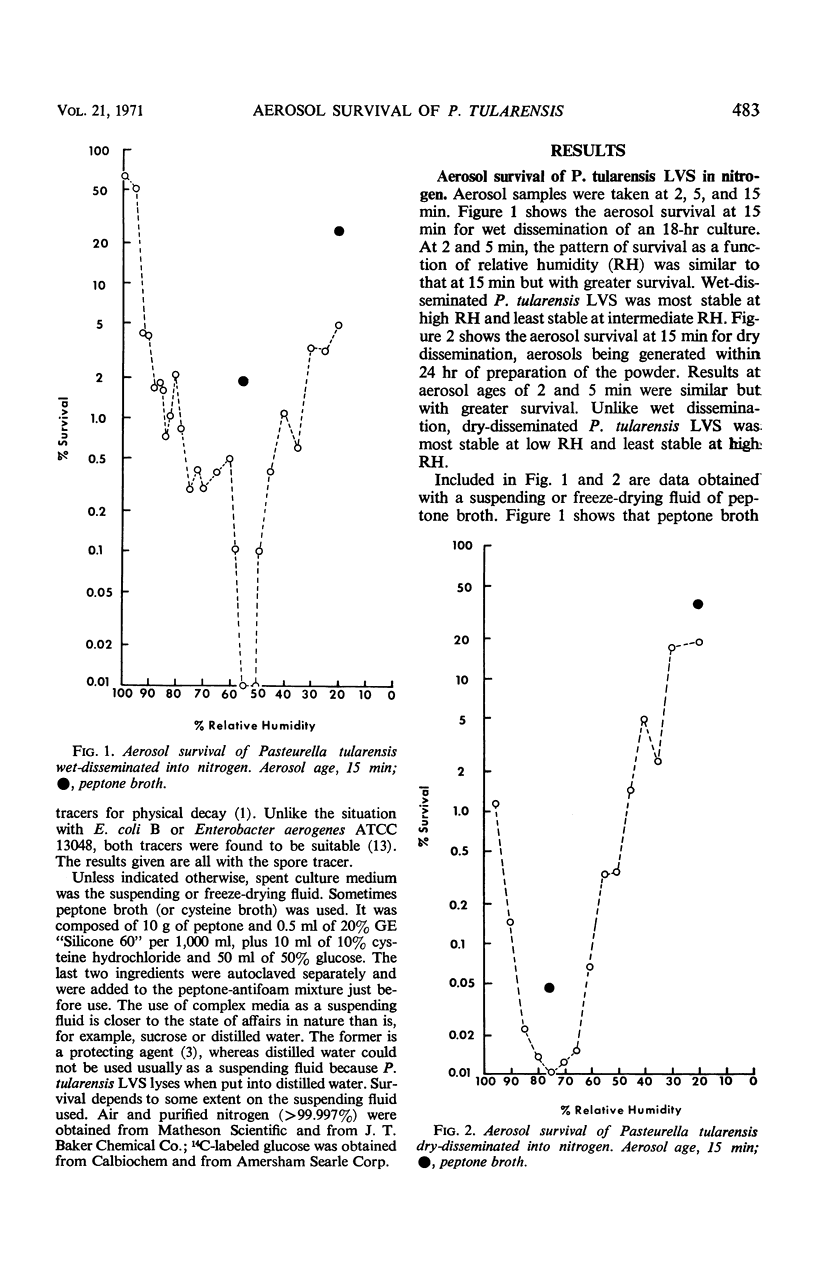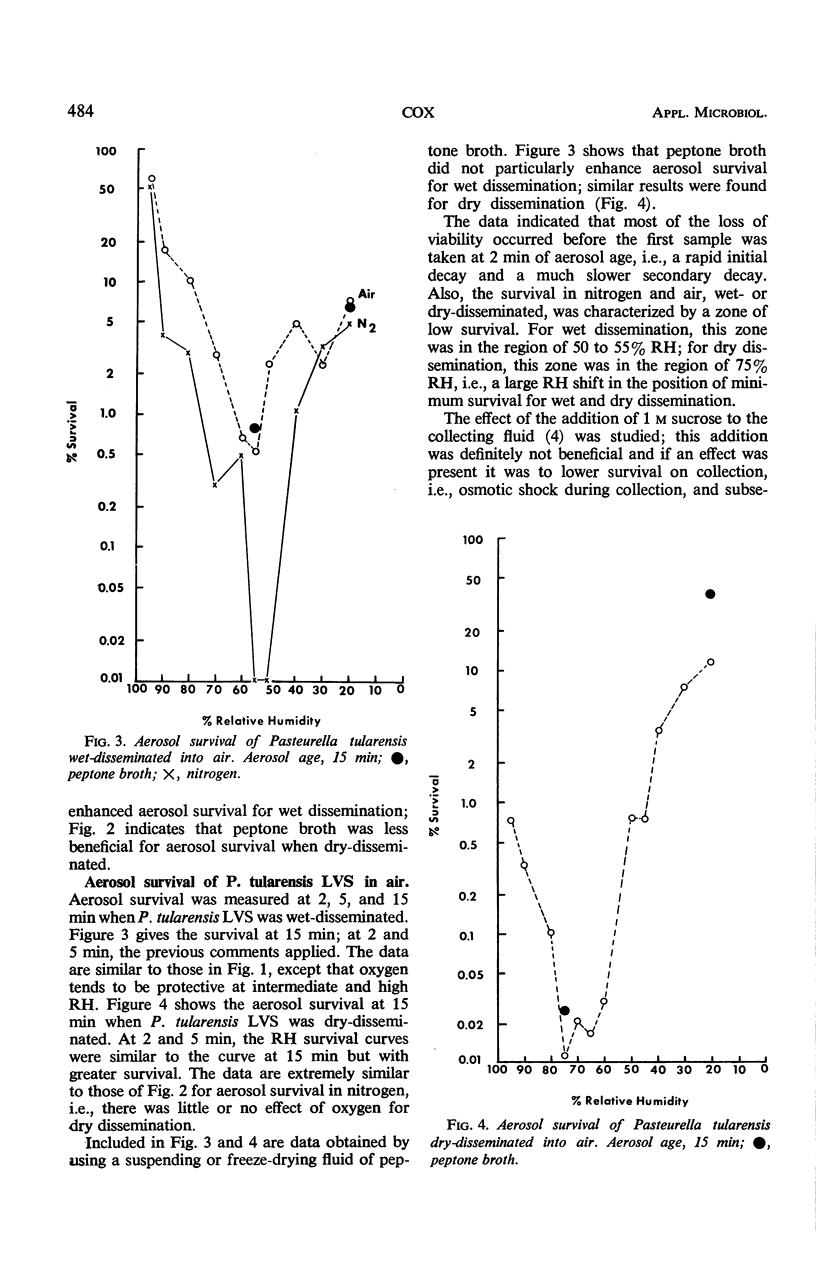Abstract
The aerosol survival in air and in nitrogen was measured for Pasteurella tularensis live vaccine strain, disseminated from the wet and dry states. The results showed that most of the loss of viability occurred in less than 2 min of aerosol age, i.e., a rapid initial decay followed by a much slower secondary decay. In nitrogen and air, minimum survival occurred at 50 to 55% relative humidity (RH) for wet dissemination and at 75% RH for dry dissemination. This shift indicated that aerosols produced by wet and dry dissemination were not equivalent and suggested that survival might not be related to bacterial water activity or content. The results showed that rehydration is the key process with regard to survival, but that lysis on rehydration is not a primary death mechanism. The effects of oxygen were complex because it could be either protective or toxic, depending upon other conditions. The protective action of oxygen was through an effect on the spent culture suspending fluid. The latter contained a toxic component, the activity of which is suppressed by oxygen; possibly the component is pumped away during freeze-drying. A toxic effect of oxygen was not found in the presence of spent culture media because the toxicity of the latter masks such an effect. With other bacterial suspending fluids, oxygen was shown to be toxic at low RH. Similar effects with regard to oxygen toxicity were also found with a laboratory strain of P. tularensis. Differences in oxygen toxicity for aerosols generated from the wet and dry states also suggest that bacterial water content and activity do not control aerosol survival.
Full text
PDF




Selected References
These references are in PubMed. This may not be the complete list of references from this article.
- Benbough J. E. Factors affecting the toxicity of oxygen towards airborne coliform bacteria. J Gen Microbiol. 1969 May;56(2):241–250. doi: 10.1099/00221287-56-2-241. [DOI] [PubMed] [Google Scholar]
- Cox C. S. Aerosol survival of Escherichia coli B disseminated from the dry state. Appl Microbiol. 1970 Apr;19(4):604–607. doi: 10.1128/am.19.4.604-607.1970. [DOI] [PMC free article] [PubMed] [Google Scholar]
- Cox C. S., Baldwin F. The toxic effect of oxygen upon the aerosol survival of Escherichia coli B. J Gen Microbiol. 1967 Oct;49(1):115–117. doi: 10.1099/00221287-49-1-115. [DOI] [PubMed] [Google Scholar]
- Cox C. S., Derr J. S., Jr, Flurie E. G., Roderick R. C. Experimental technique for studying aerosols of lyophilized bacteria. Appl Microbiol. 1970 Dec;20(6):927–934. doi: 10.1128/am.20.6.927-934.1970. [DOI] [PMC free article] [PubMed] [Google Scholar]
- Cox C. S. Method for the routine preservation of micro-organisms. Nature. 1968 Dec 14;220(5172):1139–1139. doi: 10.1038/2201139a0. [DOI] [PubMed] [Google Scholar]
- Cox C. S. The aerosol survival and cause of death of Escherichia coli K12. J Gen Microbiol. 1968 Dec;54(2):169–175. doi: 10.1099/00221287-54-2-169. [DOI] [PubMed] [Google Scholar]
- Cox C. S. The aerosol survival of Escherichia coli B in nitrogen, argon and helium atmospheres and the influence of relative humidity. J Gen Microbiol. 1968 Jan;50(1):139–147. doi: 10.1099/00221287-50-1-139. [DOI] [PubMed] [Google Scholar]
- Cox C. S. The aerosol survival of Escherichia coli JEPP sprayed from protecting agents into nitrogen atmospheres under changing relative humidity conditions. J Gen Microbiol. 1967 Oct;49(1):109–114. doi: 10.1099/00221287-49-1-109. [DOI] [PubMed] [Google Scholar]
- Cox C. S. The cause of loss of viability of airborne Escherichia coli K12. J Gen Microbiol. 1969 Jul;57(1):77–80. doi: 10.1099/00221287-57-1-77. [DOI] [PubMed] [Google Scholar]
- Cox C. S. The survival of Escherichia coli in nitrogen atmospheres under changing conditions of relative humidity. J Gen Microbiol. 1966 Nov;45(2):283–288. doi: 10.1099/00221287-45-2-283. [DOI] [PubMed] [Google Scholar]
- Cox C. S. The survival of Escherichia coli sprayed into air and into nitrogen from distilled water and from solutions of protecting agents, as a function of relative humidity. J Gen Microbiol. 1966 Jun;43(3):383–399. doi: 10.1099/00221287-43-3-383. [DOI] [PubMed] [Google Scholar]
- Downs C. M., Coriell L. L., Chapman S. S., Klauber A. The Cultivation of Bacterium tularense in Embryonated Eggs. J Bacteriol. 1947 Jan;53(1):89–100. [PMC free article] [PubMed] [Google Scholar]
- HECKLY R. J., DIMMICK R. L., WINDLE J. J. FREE RADICAL FORMATION AND SURVIVAL OF LYOPHILIZED MICROORGANISMS. J Bacteriol. 1963 May;85:961–966. doi: 10.1128/jb.85.5.961-966.1963. [DOI] [PMC free article] [PubMed] [Google Scholar]
- Hess G. E. Effects of oxygen on aerosolized Serratia marcescens. Appl Microbiol. 1965 Sep;13(5):781–787. doi: 10.1128/am.13.5.781-787.1965. [DOI] [PMC free article] [PubMed] [Google Scholar]
- Webb S. J. The influence of oxygen and inositol on the survival of semidried microorganisms. Can J Microbiol. 1967 Jul;13(7):733–742. doi: 10.1139/m67-097. [DOI] [PubMed] [Google Scholar]


